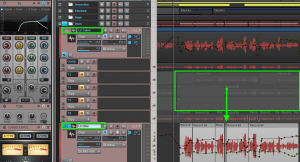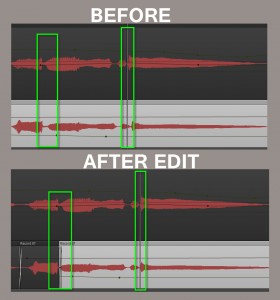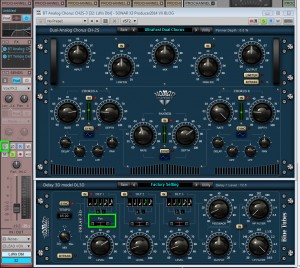One of the toughest things about working with a lead vocal track is getting it to pop out, while allowing it to still sit in the track nicely in context with its surroundings [other tracks]. Every mixing engineer has her/his bag of tricks, but here are a few ideas to utilize a “vocal-double” which may help support and embellish the lead vocal track. For this demonstration I am using the lead vocal track of NBC’s The Voice Season 1 winner Javier Colon.  Note that you can click on images to get a bigger perspective.
Note that you can click on images to get a bigger perspective.
ALWAYS GET A DOUBLE
Having the ability to use a vocal-double in a song is key, especially in some genres like pop, rock and country. By “having the ability,” I mean that you don’t have to use a vocal-double at the same level as the lead – there are a few really good techniques when using a double that are sure to give you better results than just using a single vocal take. Before you can utilize a double, you must capture a good double (or even 2 doubles). To achieve this I usually do one of two things depending on the singer.  First, I use SONAR X3’s comping system to get anywhere between 4 and 6 takes of each part of the song. Once I feel like I have what I need, I comp the tracks WHILE keeping in mind that I want to obtain a vocal-double. So after I pick the best take, I then find a take that is the closest to the best, and I simply hold down SHIFT while dragging the clip to a new “vocal-double” track. If you have a singer that usually sings the same parts the same way, this method should work well for you to obtain a decent vocal double. In some cases, you will find that the singer is more experimental with vocal delivery [melody, timing, rhythm, etc.,] and in this case you may need to have that person try to match the track you have just compiled. Singing to match the lead vocal can be a bit challenging depending on your studio monitoring. In my experience, I usually get the best (and quickest) results by tracking the double when the singer only has drums, bass (or some root-note reference such as piano) and the new lead vocal comp in their headphones. I also usually pan the comp track being played back to one side so that the singer can hear what they are trying to match a lot more clearly. Experiment with volume levels, and also try having the singer utilize one side of the headphones. Depending on what you are using the vocal double for, you generally want to try to match up all the sharp sounds such as “P” “K” “T” “ESS” etc. which can give you a lot of trouble when it comes to mixing, especially at the beginnings and endings of phrases.
First, I use SONAR X3’s comping system to get anywhere between 4 and 6 takes of each part of the song. Once I feel like I have what I need, I comp the tracks WHILE keeping in mind that I want to obtain a vocal-double. So after I pick the best take, I then find a take that is the closest to the best, and I simply hold down SHIFT while dragging the clip to a new “vocal-double” track. If you have a singer that usually sings the same parts the same way, this method should work well for you to obtain a decent vocal double. In some cases, you will find that the singer is more experimental with vocal delivery [melody, timing, rhythm, etc.,] and in this case you may need to have that person try to match the track you have just compiled. Singing to match the lead vocal can be a bit challenging depending on your studio monitoring. In my experience, I usually get the best (and quickest) results by tracking the double when the singer only has drums, bass (or some root-note reference such as piano) and the new lead vocal comp in their headphones. I also usually pan the comp track being played back to one side so that the singer can hear what they are trying to match a lot more clearly. Experiment with volume levels, and also try having the singer utilize one side of the headphones. Depending on what you are using the vocal double for, you generally want to try to match up all the sharp sounds such as “P” “K” “T” “ESS” etc. which can give you a lot of trouble when it comes to mixing, especially at the beginnings and endings of phrases.
TIGHTENING THE DOUBLE TO THE LEAD
Once you have either compiled a vocal-double from the takes, or have recorded a new vocal-double, it’s time to work on tightening the tracks together. The first thing I usually do is to get some EQ and compression going on the lead vocal comp. This is not my final processing, but it at least gets some sizzle going on the track so I have an idea of what I am working with in relation to the vocal-double. Vocal tracks react a lot differently when they are compressed and EQ’d, so the decisions I make on the double track are associated to what the lead vocal track sounds like compressed, EQ’d, and sometimes even tuned.
 Once I have my first round of processing going on the lead vocal, I then pull in the vocal-double to hear what it sounds like while being played together. This part of the process is a bit tedious and takes some patience, but it pays off when you have a really nice full sounding lead vocal from using both the lead and double together. While solo’ing both tracks, you basically want to use both your eyes and ears to find spots that don’t work well together. A lot of the times this will be at the beginnings and ending of phrases, but you want to listen closely to melody changes, vocal runs, sharply enunciated words, esses, and any other elements that may not allow these two tracks to sound tight together. When you identify trouble spots, you can easily use the editing tools in SONAR (including Melodyne if need be) to move things around so that they line up. It’s also good to keep in mind during the process the song genre on which you are working. If this is a metal track where there will be loud drums and screaming guitars, you may not need to spend as much time on tightening the vocal double as let’s say a piano/vocal ballad.
Once I have my first round of processing going on the lead vocal, I then pull in the vocal-double to hear what it sounds like while being played together. This part of the process is a bit tedious and takes some patience, but it pays off when you have a really nice full sounding lead vocal from using both the lead and double together. While solo’ing both tracks, you basically want to use both your eyes and ears to find spots that don’t work well together. A lot of the times this will be at the beginnings and ending of phrases, but you want to listen closely to melody changes, vocal runs, sharply enunciated words, esses, and any other elements that may not allow these two tracks to sound tight together. When you identify trouble spots, you can easily use the editing tools in SONAR (including Melodyne if need be) to move things around so that they line up. It’s also good to keep in mind during the process the song genre on which you are working. If this is a metal track where there will be loud drums and screaming guitars, you may not need to spend as much time on tightening the vocal double as let’s say a piano/vocal ballad.
DECIDING ON A STRATEGY FOR THE VOCAL-DOUBLE
Now that you have a vocal-double that sounds tightened to the lead vocal comp, it’s time to make some decisions. The first thing I usually do at this point is just listen to the song from beginning to end with all the instruments and the lead vocal comp. I try to focus in on “hearing [picturing]” the song’s mixed potential, and I identify “how” I want to incorporate the vocal-double. Things to consider:
- Would the vocal-double sound good at the same level throughout the whole song?
- Is it best to use the vocal-double only to enhance a part of the song such as the chorus?
- Would it be a good idea to use the vocal-double at a low level in the verses and then match the gain of the lead vocal in the chorus?
- Is the vocalist such a good singer that an obvious vocal-double track will take away from the authenticity of the performance?
These questions may sound heavy, but the folks who are making the real-deal tracks that we hear on the radio take these considerations very seriously, and all small decisions like this add up to one amazing production [or not].
PROCESSING TECHNIQUES FOR THE VOCAL-DOUBLE
 By now you should have a good sounding raw vocal-double track, and hopefully a general idea on how you are going to use it. Now comes the fun part; trying to create the magic-potion-special-sauce that will embellish the lead vocal and the song as a whole. Start with the compression and EQ. I generally compress the vocal-double pretty hard with a 8:1 ratio (or similar with the CA-2A) and depending on the speed of the song and other elements, adjust the attack and release accordingly. The CA-2A is my go-to compressor a lot on this kind of processing because you literally cannot go wrong with it on vocals. The EQ’ing is the more important participant to the party here, and a good approach for the double is to use the killer filtering roll-offs on both the high and low end frequencies. You may not hear it now, but by cutting the lows you will clear up much needed space under 300hz, and this will also give the double some definition especially after being compressed. By rolling off the highs, you will make the track “mesh” better with the lead vocal track because the sharp/harsh sounds along with sibilance will be tamed.
By now you should have a good sounding raw vocal-double track, and hopefully a general idea on how you are going to use it. Now comes the fun part; trying to create the magic-potion-special-sauce that will embellish the lead vocal and the song as a whole. Start with the compression and EQ. I generally compress the vocal-double pretty hard with a 8:1 ratio (or similar with the CA-2A) and depending on the speed of the song and other elements, adjust the attack and release accordingly. The CA-2A is my go-to compressor a lot on this kind of processing because you literally cannot go wrong with it on vocals. The EQ’ing is the more important participant to the party here, and a good approach for the double is to use the killer filtering roll-offs on both the high and low end frequencies. You may not hear it now, but by cutting the lows you will clear up much needed space under 300hz, and this will also give the double some definition especially after being compressed. By rolling off the highs, you will make the track “mesh” better with the lead vocal track because the sharp/harsh sounds along with sibilance will be tamed.
Using an analyzer at this point is a good idea to see what the frequencies look like in your singer’s voice. You can find some very interesting sounds by experimenting with the EQ. For example, if you find that the singer is lacking some mid-range frequencies, try turning down the gain considerably while boosting that frequency range considerably. If you have used the filters mentioned above, don’t be afraid to experiment with boosting and cutting frequencies on the vocal double to match or embellish the lead vocal track – HAVE FAITH IN YOUR EAR.
 Another technique I use quite often is to actually use a “vocal doubler” on the double itself [say that 10 times fast ;-).] Additionally, and depending on the singer, type of song, and vocal-double strategy, I will also use a mono delay run up the middle 10%-ish wet. I find that this can help to blend the vocal-double with the lead vocal. It’s also important to note that you can experiment with Mono vs. Stereo processing here with the vocal-double. By flicking the track switch to stereo, you can run your chorus insert effect in stereo for width while still keeping your delay up the middle [see photo]. I sometimes will also use an auxiliary send from the double going to any of the effects the lead vocal uses. This technique really helps bring the two tracks together so that they sound closer to one glued performance.
Another technique I use quite often is to actually use a “vocal doubler” on the double itself [say that 10 times fast ;-).] Additionally, and depending on the singer, type of song, and vocal-double strategy, I will also use a mono delay run up the middle 10%-ish wet. I find that this can help to blend the vocal-double with the lead vocal. It’s also important to note that you can experiment with Mono vs. Stereo processing here with the vocal-double. By flicking the track switch to stereo, you can run your chorus insert effect in stereo for width while still keeping your delay up the middle [see photo]. I sometimes will also use an auxiliary send from the double going to any of the effects the lead vocal uses. This technique really helps bring the two tracks together so that they sound closer to one glued performance.
So at the end of the day, a typical vocal-double in the mix may look like this:
* Tightened up to the lead vocal track (cuts, fades, cleaned for noise, etc.)
- Compressed to taste – {RED}
- EQ with both High Pass and Low Pass filtering {DARK GREEN}
- High Pass to get rid of low frequencies
- Low Pass to help blend in any differences between the lead vocal and lead double
- A light doubler or chorus on the vocal-double [Insert] {ORANGE}
- A light delay effect in time on the vocal-double [Insert] (optional) {PURPLE}
- Auxiliary sends to some or all of the lead vocal bus effects (determined by ear) {BRIGHT GREEN}
- Output of vocal-double going to the “lead vocal bus” {BLUE}
- This bus also has the Lead Vocal track
- Usually has a limiter and maybe even another light compressor
- Usually has EQ above 15khz boosted depending on the EQ of the Lead Vocal track
- Fader relationship between Lead and Double (Subjective) {YELLOW}
- Lead Vocal bus EQ boosted for presence (Subjective) {ORANGE}
IN THE MIX
It’s a matter of taste and preference on a song by song basis, but here are examples of a lead vocal with, and without a vocal-double:
This is essentially the easy part, but it’s most important to pay attention to what the vocal-double effect does to the lead singer’s voice; and ultimately how that works “for the song.” For example, here with Javier I elected to keep the vocal double off in the verses, and then kick them up a in the choruses. We decided that there was a lot going on in this chorus already, so we didn’t add any backing vocals; this is a good place to use a double as an embellishment in some cases.
It’s easy to go down the road of always using a double just because it sounds stronger, but there absolutely are times where you want a more “personal” and authentic sounding vocal where a single track works best. Vocal-doubles can work really well in rock songs where there are a lot of instruments happening. I have even gone as far as using vocal “triples” where the lead is run up the middle, and two doubles are run left and right for an effect. If you have never used a vocal-double, I recommend experimenting with different techniques weighing more towards the cautious side until you find what works best for you.
Thanks for reading. jl


